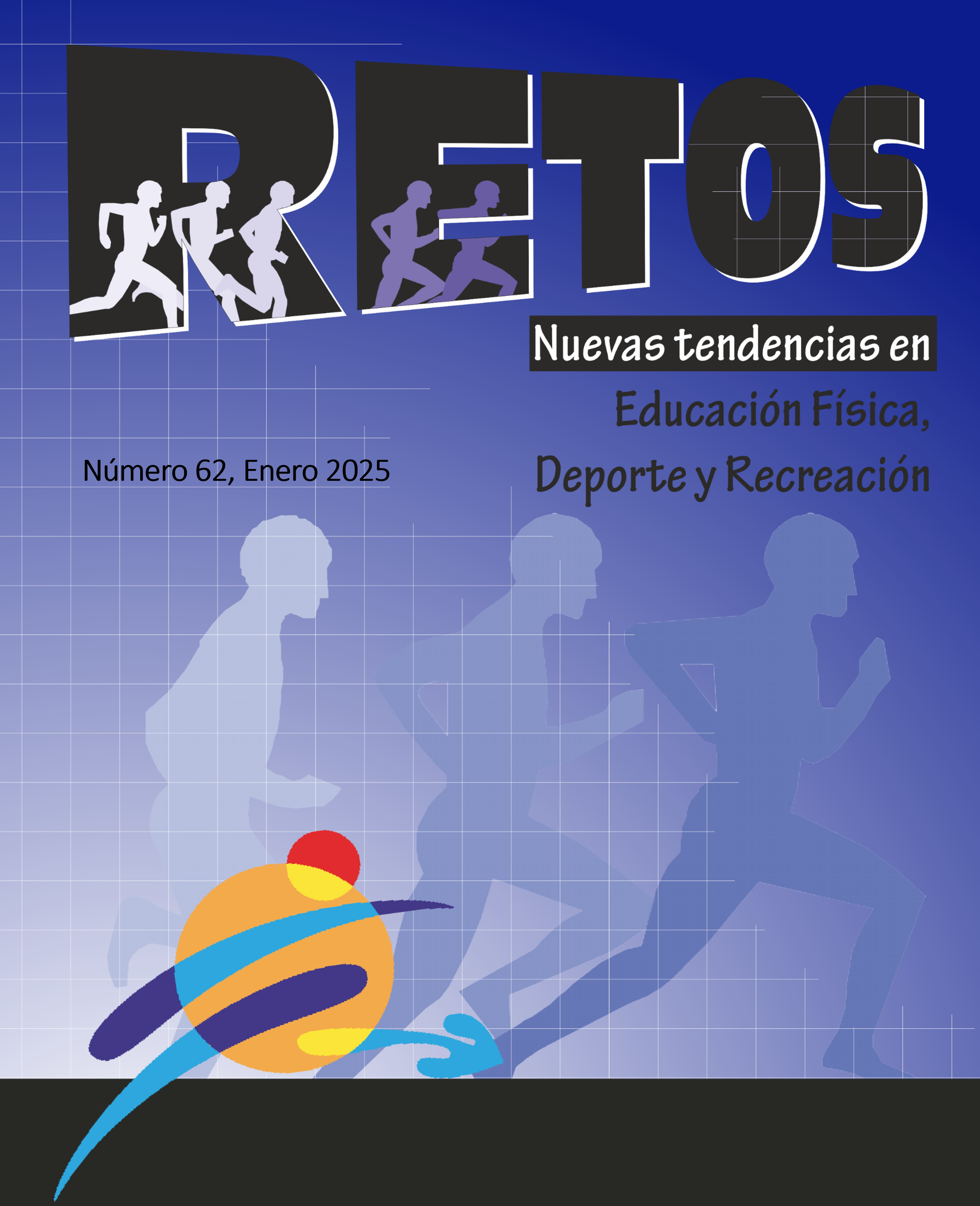The effect of strength training on upper extremities strength and ball throwing velocity in blind goalball athletes
DOI:
https://doi.org/10.47197/retos.v62.110645Keywords:
strength training, strength upper extremities, ball throwing velocity, goalballAbstract
Throwing technique in goalball game is the main attack to score a goal. The study aims to determine the effect of strength training on upper extremity strength and ball throwing velocity in blind goalball athletes. This study was used experimental study. Twenty goalball athletes aged 22.15±1.39 years, height 155.75±4.90 cm, and weight 56.67±5.96 kg participated in this study to evaluate the applied training, undergoing treatment for 8 weeks. Participants underwent upper extremities strength and ball throwing velocity testing before and after treatment. Parametric paired t test was used for data analysis with a significance of 0.05. Paired t-test showed tcount = 17.178 (p-value = 0.000) for TW_5s, tcount = 37.338 (p-value = 0.000) for TW_15s, and tcount = 9.303 (p-value = 0.000) for BTV, which showed an increase in upper extremities strength and ball throwing velocity after blind goalball athletes underwent strength training for 8 weeks. Strength training can be a choice for coaches as an optimal training strategy to increase upper extremity strength and ball throwing velocity in blind goalball athletes.
References
Bataller-Cervero, A. V., Bascuas, P. J., Rabal-Pelay, J., Gutiérrez, H., Piedrafita, E., & Berzosa, C. (2022). Attack and defense performance in goalball: a proposal for throwing, balance and acoustic reaction evaluation. Biology, 11(8), 1234.
Bowerman, S., Davis, R., Ford, S., & Nichols, D. (2011). Phases of movement of goalball throw related to ball veloci-ty. Insight, 4(4), 153-9.
Bushenyova, I. S., Marchenko, A. A., & Torosyan, I. G. (2021). Development Of Physical Qualities Among 20-22 Years Old Goalball Players. Современные вопросы биомедицины, 5(2).
de Campos, L. F. C. C., Campos, K. C., Oñate, J. G., Rocha, C. E. L., dos Santos, L. G. T. F., & Plaza, R. S. (2020). Characterization of Chilean goalball paralympic athletes and association between anthropometric variables, body composition and strength in ball throwing. Retos, 38, 40-43.
Ferreira, M., & Tosim, A. (2023). Indicators of Excellence in High Performance Goalball – A Systematic Review. Retos, 50, 1251-1264.
Floyd, B., & Mowling, C. (2019). Goalball: Strategies for Teaching One Paralympic Sport in Inclusive Physical Educa-tion. ASAHPERD Journal, 39(2), 22-27.
Godoy-Cumillaf, A., Ramírez, N. F., & Fuentes-Merino, P. (2022). Cardiorespiratory fitness and morphological charac-teristics in goalball players. Retos, 44, 946-951.
Goulart-Siqueira, G., Benítez-Flores, S., Ferreira, A. R., Zagatto, A. M., Foster, C., & Boullosa, D. (2018). Relation-ships between different field test performance measures in elite goalball players. Sports, 7(1), 6.
Jorgić, B., Grbović, A., Đorđević, S., Stanković, V., & Stanković, R. (2019). Influence of Certain Motor Abilities on Ball Throwing Velocity in Goalball: a Pilot Study. Facta Universitatis, Series: Physical Education and Sport, 17(2), 195. https://doi.org/10.22190/fupes190904020j
Krzak, J., Ślężyńska, M., & Ślężyński, J. (2015). Goalball as an effective means of physical improvement for blind and visually impaired players. Medycyna Ogólna i Nauki o Zdrowiu, 21(4).
Marques, M. C., Van Den Tillaar, R., Vescovi, J. D., & González-Badillo, J. J. (2007). Relationship between throwing velocity, muscle power, and bar velocity during bench press in elite handball players. International journal of sports physiology and performance, 2(4), 414-422.
Szafraniec, R., Kisilewicz, A., Kumorek, M., Kristiansen, M., Madeleine, P., & Mroczek, D. (2020). Effects of high-velocity strength training on movement velocity and strength endurance in experienced powerlifters with cerebral palsy. Journal of Human Kinetics, 73(1), 235-243.
Turbanski, S., & Schmidtbleicher, D. (2010). Effects of heavy resistance training on strength and power in upper ex-tremities in wheelchair athletes. The Journal of Strength & Conditioning Research, 24(1), 8-16.
Vanlandewijck, Y. C., & Thompson, W. R. (2016). Training and Coaching the Paralympic Athlete. USA: John Wiley & Sons, Inc.
Downloads
Published
How to Cite
Issue
Section
License
Copyright (c) 2024 Rumi Doewes, Slamet Widodo, Hendrig Joko Prasetyo

This work is licensed under a Creative Commons Attribution-NonCommercial-NoDerivatives 4.0 International License.
Authors who publish with this journal agree to the following terms:
- Authors retain copyright and ensure the magazine the right to be the first publication of the work as licensed under a Creative Commons Attribution License that allows others to share the work with an acknowledgment of authorship of the work and the initial publication in this magazine.
- Authors can establish separate additional agreements for non-exclusive distribution of the version of the work published in the journal (eg, to an institutional repository or publish it in a book), with an acknowledgment of its initial publication in this journal.
- Is allowed and authors are encouraged to disseminate their work electronically (eg, in institutional repositories or on their own website) prior to and during the submission process, as it can lead to productive exchanges, as well as to a subpoena more Early and more of published work (See The Effect of Open Access) (in English).
This journal provides immediate open access to its content (BOAI, http://legacy.earlham.edu/~peters/fos/boaifaq.htm#openaccess) on the principle that making research freely available to the public supports a greater global exchange of knowledge. The authors may download the papers from the journal website, or will be provided with the PDF version of the article via e-mail.


